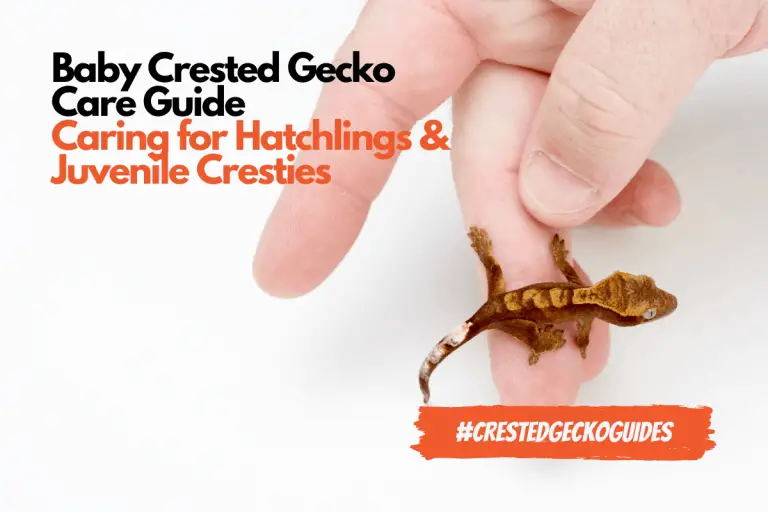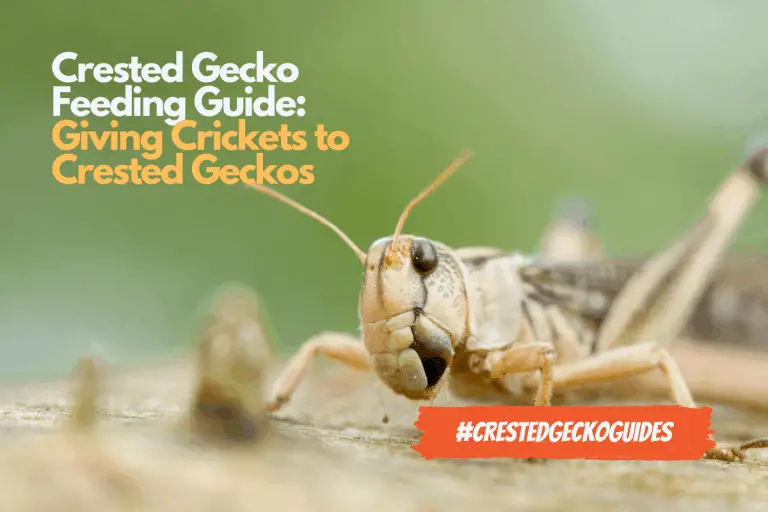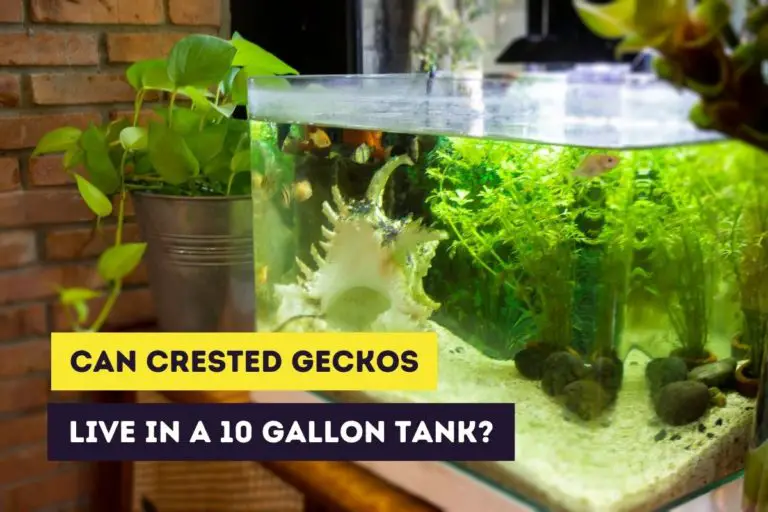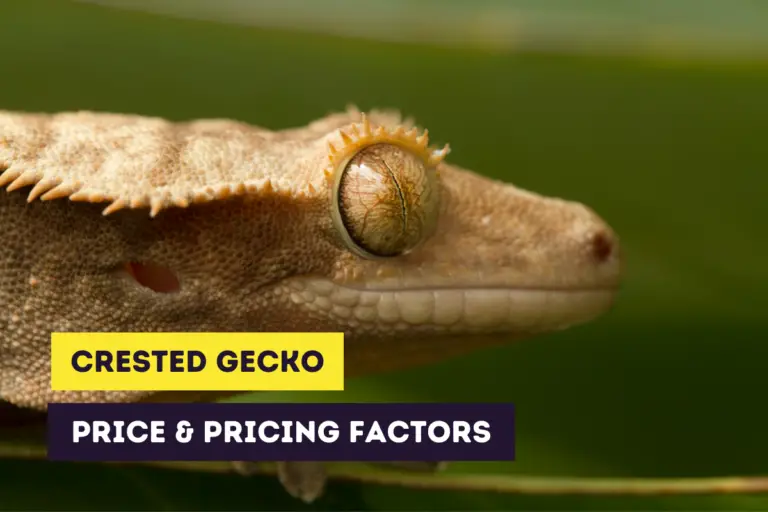Humidity Needs of Crested Geckos: Ideal Range and Misting
Estimated reading time: 8 minutes
Crested geckos are subtropical lizards and prefer a humid terrarium. Contrary to popular belief, they’re not tropical lizards that require high temperatures and extremely high humidity. But humidity does play an important role in the life of a crested gecko and shouldn’t be neglected.
Crested geckos need a relative humidity of 70 to 80 percent in captivity. An average humidity higher than 80 percent will cause health problems in the long run. An average humidity lower than 50 percent will cause dehydration and shedding problems.
Like temperature and lighting, good humidity is something that isn’t set in stone. There are a lot of factors that come into play. So whether the relative humidity is 65 percent or 70 percent doesn’t matter that much. It would be best if you aimed to get an average humidity that falls in the ideal range, but humidity will need to fluctuate throughout the day.
If you’re interested in stickers or other products of crested geckos, you can always visit our Etsy Shop, which is called Artful Animalia. We currently only send stickers in the United States. If you’re interested in certain crested gecko-related products, don’t hesitate to contact us.
In this article, you’ll learn what a good humidity level is for crested geckos and how to create an environment for your cresties that’s not too humid and not too dry. Many factors determine if you can keep the humidity at a decent level, and you’ll learn how to use each one.
This site contains affiliate links to products we recommend and use ourselves. We may receive a commission for purchases that you make through these links. If you’re interested in learning more about our affiliate links, please visit our (affiliate) disclaimer.
Do Crested Geckos Need Humid Vivaria?
Natural environment
Crested geckos are native to the south of New Caledonia. Populations of crested geckos are found in three separate locations:
- Isle of Pines
- Blue River (Grande Terre)
- south of Mount Dzumac (Grande Terre)
To determine whether or not crested geckos need a humid terrarium and how humid it should be, we have to look at the humidity levels in their natural habitat. As you can see in de table below, New Caledonia has an average relative humidity of around 76 percent, with peaks of 80 percent in the wet season and lows of 70 percent in the dry season.

The humidity in New Caledonia changes throughout the day, just as in the rest of the world. The humidity can get as low as 50 percent from the morning until the afternoon. However, when night comes, the humidity levels generally rise and reach up to 90 percent. A lot of factors play a role in creating these humidity levels.
Why is humidity important for crested geckos?
Crested geckos are used to high humidity levels and have adapted to live in a humid environment. Humidity plays a vital role in the life of a crested gecko and is essential to keep your crested gecko happy and healthy. In particular, it’s important because:
- it helps a crested gecko to shed properly
- your crested gecko needs to stay hydrated and high humidity helps with this
Many shedding problems are caused by dehydration and an average low humidity level in the terrarium. You can easily avoid these problems when there isn’t an underlying health issue.
Humidity Levels for Crested Geckos
What is the ideal humidity for crested geckos?
The ideal (average) humidity levels for crested geckos range from 70 to 80 percent, although crested geckos can tolerate humidity levels of 50 percent. It’s even recommended to let the humidity level drop gradually until about 50 percent. This will prevent bacterial and fungal growth in your terrarium.
Although humidity levels above 80 percent are sometimes recommended to help with shedding, they’re not ideal. They will hurt your crested gecko’s health when you expose them to such high levels for a long time without lowering the humidity.
Measuring the humidity levels
One of the essentials on your shopping list for your crested gecko should be a hygrometer. This is a device that measures the humidity levels in a terrarium. Like a thermometer, a hygrometer tells you what percentage of relative humidity is in the air. There are analog and digital hygrometers. Some brands even have devices that combine a hygrometer and a thermometer.
If you don’t know which one to choose, I suggest getting a digital hygrometer or a two-in-one. However, you should be aware that some crested gecko kits, like the habitat kits from Exo Terra, come with an (analog) hygrometer, which is fine.
How To Create a Humid Vivarium
Different factors come into play when creating a humid terrarium. You can easily influence some of these factors while others require more advanced knowledge.
The humidity of a terrarium is determined by:
- the type of enclosure
- the region you’re living in and/or the general humidity in your house
- your choice in vivarium plants
- the kind of substrate you use
Besides these factors, there’s one easy way to quickly and cheaply increase the humidity in a terrarium: misting!
If you got problems creating a high humidity terrarium, you might need to invest some money in a humidifier. However, for most of you, this will probably not be necessary.
The type of enclosure
There are different types of enclosures for crested geckos. If you didn’t already choose, it’s an excellent idea to read our housing guide to learn the advantages and disadvantages of the different types.
The most popular choices are tanks and terrariums (sometimes called vivariums). These enclosures have the benefit of holding in the humidity well, but you should make sure that there’s enough ventilation to lower the humidity levels gradually.
On the other hand, screen or mesh cages are also suitable for crested geckos, but they have a problem keeping the humidity levels reasonably high throughout the day. This is because the water vapor can escape through the mesh and there’s ventilation from all sides of the enclosure.
From a humidity standpoint, a terrarium (or vivarium) is the best choice for most of you. It will keep the humidity at ideal levels and most terrariums still have good ventilation.
Vivarium plants
Live vivarium plants and mosses will naturally give off moisture or water vapor while they go through photosynthesis. The process in which water vapor is released into the air is called transpiration. The transpiration of plants is a bit the same as human sweating and the water vapor lets the leaves cool down.
Several factors influence the rate of transpiration:
- temperature: when the temperature in a terrarium is high, the rate of transpiration will increase. A hot terrarium with live plants will lead to a naturally more humid terrarium.
- humidity: an already humid terrarium will decrease the rate of transpiration of the plants. It’s a sort of autoregulation and this process will also cause the humidity to drop less than when there wouldn’t be live plants.
- ventilation: when there’s a lot of ventilation the evapotranspiration rate increases. This is mostly due to the fact that the humidity is lowered by the ventilation. In response, there will be a higher rate of transpiration.
- water availability: evapotranspiration uses water and if there isn’t a lot of water in the soil there will be no evapotranspiration.
- soil type: the soil type determines how much water the soil can hold and how easy the plant can draw water from it. When the ground is covered by vegetation, the rate of transpiration is higher than the evaporation rate from the soil.
- plant type: some plants, like succulents, naturally hold onto their water and don’t transpire much. Other plants release more water.
Both live and fake plants can be used in a crested gecko terrarium but live plants have a specific benefit in increasing the humidity in the terrarium. Make sure that they’re safe to use and don’t grow too big.
Substrates
The substrate you choose for your terrarium can significantly influence the humidity. The substrates that have the best retention of moisture and keep the humidity in a terrarium up are:
- orchid bark
- cypress mulch
- coconut husk
Misting and humidifiers
Misting
You have probably already heard about the term misting before. It’s no different than using a spray bottle to increase the humidity in a terrarium. Misting is an easy and cheap way to increase humidity, especially in dry regions.
You should always watch the hygrometer to guide you with the terrarium’s humidity levels, but most people will need to mist in the evening and the morning. The humidity levels should be around 80 to 90 percent in the evening. Let the humidity drop for 12 hours to 50 percent and then mist again.
If you notice that the humidity levels drop faster and reach levels below 50 percent, you need to mist more often with less time in between.
The water you use to mist should be tap water, which contains minerals vital for crested geckos. Never use distilled, softened or filtered water!
Humidifiers
If you don’t want to spray each day with a misting bottle or live in a dry area and keep the humidity levels up is a problem, you want to invest in a humidifier. There exist humidifiers for a room or specifically for the enclosure. However, you should be aware that these tank humidifiers aren’t cheap and can easily cost more than $100.
Extra Tips
To give you an extra edge when it comes to keeping the ideal humidity levels, you can use the following tips:
- never mist directly on the hygrometer: this will cause a wrong reading where the humidity levels are in fact lower than the hygrometer indicates.
- use a water bowl: crested geckos don’t always drink from a water bowl. Instead, they lick up droplets from the terrarium plants. Still, it’s recommended to also give water in a water bowl. The water will slowly evaporate and slightly increase humidity.
- mist both the terrarium as the plants: this will allow droplets to form on the leaves and walls of the terrarium. Your crestie can then lick up these droplets.
Want to Learn More?
If you want to learn more about crested geckos as pets, please read the following articles.
If you’re interested in getting crested geckos as pets you should also definitely read our article about baby and juvenile crested gecko care or (adult) crested gecko care.







